PU foam stress balls are a popular promotional product because they’re cheap and work for stress relief. If you’re a buyer, especially in a B2B situation, understanding how to choose the right molds is important for keeping production efficient and ensuring high product quality. In this article, I’m going to walk you through the key factors of PU stress ball molds, including material options, lifespan, cost, and proper storage. With this information, you’ll be able to make better purchasing decisions that can streamline your production process and control costs effectively.
Mold Materials
The material you use for your molds is important because it affects the quality of your production, how much it costs you, and how long your molds last. Here’s a comparison of the different materials you can use for your PU foam stress ball molds:
| Material | Advantages | Disadvantages |
|---|---|---|
| Aluminum | Lightweight, good heat conductivity, corrosion-resistant | Higher cost |
| Steel | Strong, wear-resistant, long lifespan | Heavy, complex to process |
| Copper (Spray Mold) | Excellent conductivity, corrosion-resistant, durable | High cost |
Each material has its own purpose and you can choose the one that works for you based on what you’re doing and how much money you have.
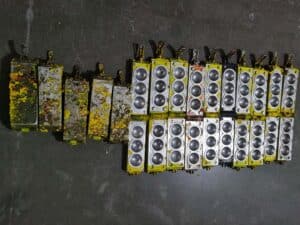
How to Choose Mold Materials
Here are some things to think about when you’re trying to decide which mold material to use:
| Factor | Considerations |
|---|---|
| Production Volume | For high-volume production, durable materials like steel or aluminum are recommended for their longevity. |
| Budget | If you are working with a limited budget, aluminum molds offer a good balance between cost and performance. |
| Product Precision | For products requiring high precision, aluminum molds are often preferred for their accuracy and lightweight handling. |
You need to balance the size of your production and your budget to make sure you’re being cost-effective but not being cheap.
Example Scenario
To better understand how to select molds, let’s consider a sample order of 5,000 PU stress balls.
| Scenario | Details |
|---|---|
| Order Quantity | 5000 Units |
| Sampling | Typically, 1-2 sets of aluminum or steel foam molds are needed for sampling and small batch production. |
| Mass Production | The molds used for sampling can continue to be used for mass production, but additional molds may be needed to improve production efficiency. Generally, it is recommended to add 3-5 more foam molds. It depends on the stress ball size and order qty. |
| Mold Types | The molds used for sampling and mass production are the same, ensuring product consistency and stable quality. |
Necessary Molds for Producing PU Stress Balls
YoTo produce PU foam stress balls, you will need two main types of molds:
| Mold Type | Usage |
|---|---|
| Foam Molds | Used for injecting polyurethane foam. Typically, 1-2 sets of foam molds are needed per product. |
| Spray Painting Molds | Used for painting the finished stress balls to ensure uniform coloring. |
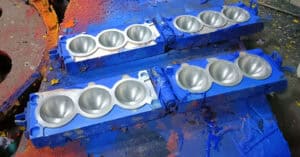
Structure and Characteristics of Foam Molds
Foam molds are made up of two halves, the top, and the bottom, that come together to make the whole mold. Here are some important things to know about foam molds:
- Seam Line: When the two halves of the mold come together, a seam line is down the middle of the product. You can’t get rid of this seam line completely. However, you can trim the extra material along the seam line with a pair of scissors for a smoother finish.
- Cavities: The number of cavities in a mold varies depending on the size of the product:
| Ball Size | Cavities per Mold |
|---|---|
| 5-7 cm | 3 cavities |
| 4 cm | 4 cavities |
| 8-10 cm | 2 cavities |
| 11 cm or larger | 1 cavity |
The more cavities a mold has, the fewer molds are needed to fulfill the same order quantity. On the other hand, molds with fewer cavities will require more molds for the same order, which means higher mold costs for your client.
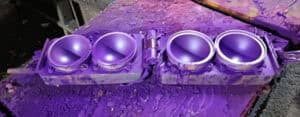
Why Do Molds Have Limited Cavities?
There are several reasons why PU stress ball molds often have a limited number of cavities:
- Injection and Filling: After the raw material is injected into the mold cavities, the operator must manually rotate the mold in six directions (front, back, left, right, up, and down) within a few seconds. This process ensures that the liquid material fully flows into every part of the cavities and that all air is expelled, guaranteeing the quality of the product.
- Weight Control: The weight of the mold must be kept within manageable limits (typically under a certain number of kilograms). If the mold is too heavy, operators will struggle to rotate it efficiently throughout the day. Rotating the mold requires skill, strength, and the correct technique to ensure even distribution of the material and proper product formation.
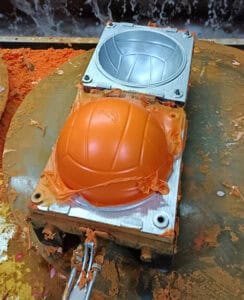
Spray Mold Materials and Usage
Spray molds are usually made out of copper because it’s a great conductor of heat and electricity and it doesn’t rust. Here’s a summary of the different spray mold materials:
| Material | Advantages | Disadvantages |
|---|---|---|
| Copper | High conductivity, durable, corrosion-resistant | High cost |
Steps for Using Spray Molds:
The process of using spray molds is relatively straightforward. Follow these steps:
| Step | Description |
|---|---|
| Install the Mold | Fix the spray mold on the spray table. |
| Place the Product | Place the foamed stress ball into the mold. |
| Spray Paint | Use automatic or manual spray equipment to paint the stress ball evenly. |
| Drying | Allow the painted stress ball to dry in the wooden tray, ensuring a smooth and even paint surface. |
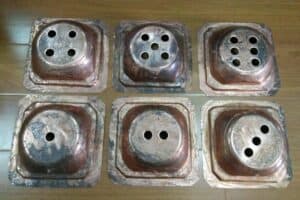
Mold Lifespan
The lifespan of a mold varies depending on the material used. Below is an overview of typical mold lifespans:
| Mold Type | Lifespan |
|---|---|
| Aluminum Foam Mold | 50,000-100,000 cycles |
| Steel Foam Mold | Over 100,000 cycles |
| Copper Spray Mold | 20,000-100,000 times |
Selecting a material with a longer lifespan will save you money in the long term, especially for high-volume production.
Mold Costs
The cost of molds depends on the materials and how complicated the processing is. It depends on your order qty and mold qty. This is only for reference.
| Mold Type | Cost Range (USD) |
|---|---|
| Aluminum Foam Mold | 1,000-5,000 |
| Steel Foam Mold | Over 10,000 |
| Copper Spray Mold | 500-3,000 |
These costs provide a general idea but may vary depending on your supplier, product complexity, and order volume.
Copper Mold Cost Considerations
The costs I just gave you for copper molds are just an idea. They can vary depending on the size, shape, and complexity of the products. Here’s a cost breakdown:
| Consideration | Details |
|---|---|
| Initial Cost | Copper mold costs are only charged once during the sampling phase and are included in the sampling fee. |
| Usage in Mass Production | The same copper molds used for sampling will continue to be used for mass production without additional mold fees. |
Mold Cost Refund
In some cases, it’s possible to receive a refund for mold costs under the following conditions:
| Scenario | Details |
|---|---|
| High-Volume Orders | For large orders, manufacturers may offer a full or partial refund of the mold costs after a certain quantity is produced. |
| Long-Term Contracts | Committing to a long-term supply agreement may also result in mold cost refunds or discounts. |
| Negotiation | Always negotiate with your supplier to understand their policies on mold cost refunds and incorporate favorable terms into your contract. |
How to Store Molds
Proper mold storage can greatly extend their lifespan. Here are some best practices:
| Storage Practice | Description |
|---|---|
| Regular Cleaning | Clean molds regularly to prevent residue buildup, which can affect mold quality. |
| Proper Storage | Store molds in a dry, dust-free environment to avoid corrosion and damage. |
| Temperature Control | Keep storage temperatures between 10-30°C to avoid material expansion and contraction, which can affect mold precision. |
| Humidity Control | Maintain relative humidity between 40%-60% to prevent mold materials from rusting or corroding. |
| Regular Maintenance | Regularly check for wear and tear and perform necessary repairs. |
Conclusion
Mold Material Selection Guide
| Material | Advantages | Disadvantages | Applicable Situation |
|---|---|---|---|
| Aluminum | Lightweight, good thermal conductivity, corrosion-resistant | High cost | Large-scale, high-precision production |
| Steel | High strength, wear-resistant, long lifespan | Heavy, complex processing | Large-scale, high durability needs |
| Copper | Good conductivity, corrosion-resistant, wear-resistant | High cost | Spray molds, and uniform coloring needs |
If you have any questions or need help, email me or call me directly. We’re happy to work with you!

